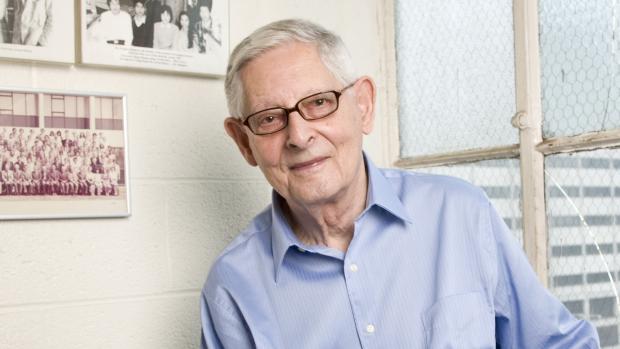In Memoriam: Arnošt Reiser

The NYU Polytechnic School of Engineering community mourns the passing of Arnošt Reiser—a respected chemist and professor—on August 4, 2015, at the age of 95. In the world of industry, Reiser was renowned for his work on a light-sensitive varnish called a “photoresist” that made possible the invention of the transistor and subsequent semiconductor revolution. Within Poly, he was equally renowned for his teaching prowess, deep interest in his students, and willingness to engage with young people—even well after he had retired from the classroom.
Reiser was born on July 5, 1920 and raised in the cosmopolitan city of Prague. While he had always loved literature and music, he became fascinated by science as a young man, and after taking a university-level chemistry course for laboratory technicians, he realized immediately that he had found a calling.
It was, however, a difficult time to be Jewish in Prague. The outbreak of World War II brought several decrees aimed against Jews, including a strict curfew, confiscation of radios, a freeze on bank accounts, and widespread bans on employment. Devastatingly, in mid-1940 Jewish children were barred from Czech public schools, and Reiser stepped in to teach lessons in math and science to local students excluded from their former classrooms.
In May of 1942, with Hitler making major inroads into Europe, Reiser was sent to the infamous Nazi concentration camp at Theresienstadt. “I met quite a few eminent scientists there,” he has said. “They were clearly inspired people and even in the camp, they were curious about the world and about life. Their attitudes made a huge difference, and they became role models for all of us young ones.”
Reiser was later sent to Auschwitz and subsequently liberated from Gross Rosen camp. Upon his return to Prague, he set about earning a degree at the Institute of Chemical Technology. In 1947 he joined the chemistry faculty there, and with his classmate, Eduard Hála, he wrote an essential Czech textbook, Physical Chemistry. Despite that professional accomplishment, life in Communist-ruled Czechoslovakia was far from easy, and in 1960 Reiser, his wife, and two young sons escaped to Denmark.
The family later relocated to England, where Reiser had received an offer from Kodak to work as an industrial chemist. He was put in charge of its photochemistry laboratory, where he and his team performed tests on photoresists that were used by Nobel laureate William Shockley, who created the transistor. “What none of us knew at the time,” Reiser once recalled, “was that we had stumbled onto the very beginnings of the semiconductor revolution.”
Reiser, who was granted a national degree of Doctor of Science by Prince Charles in honor of his work at Kodak, joined the Poly faculty in 1982. Here he taught numerous popular courses and continued his important research, some of which led to the establishment of thermal plates as a principal medium of the printing industry.
Long after Reiser, who was ultimately named a Distinguished Research Professor of Chemical and Biological Sciences, had retired from active teaching, he continued to come to the MetroTech Center each weekday. Former students who had gone on to esteemed careers of their own often visited to pay their respects and thank him. He occasionally patronized the cafeteria for an early breakfast and took special delight in conversing with a new generation of students, with whom he felt a deep kinship. “[They] come from all corners of the earth,” he explained. “They often have to overcome substantial obstacles and they come with glorious expectations.”
Reiser passed away in Rogers Hall, where he had spent countless hours over more than three decades. Our heartfelt condolences go to his wife, Ruth, and the rest of his family.




